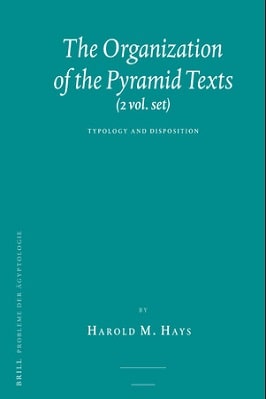
| Book Title | The Organization Of The Pyramid Texts |
| Book Author | Harold M. Hays |
| Total Pages | 754 |
| Book Views | |
| Language | English |
| Book Download | PDF Direct Download Link |
| Get Hardcover | Click for Hard Similar Copy from Amazon |
The Organization of the Pyramid Texts – Typology and Disposition (Volume One)
By Harold M. Hays
THE ORGANIZATION OF THE PYRAMID TEXTS – TYPOLOGY AND DISPOSITION (VOLUME ONE)
Book PREFACE
The object of this study is to outline the salient contours of organization of the oldest manifestation of ancient Egyptian mortuary literature, the Pyramid Texts, as they are attested in the pyramids of the last kings of the Old Kingdom.
It deals with the genre relations between texts and their physical arrangement in tombs. Through this, the characteristics of their genesis can be apprehended.
At its core, this book is an extension of my doctoral thesis, The Typological Structure of the Pyramid Texts and Its Continuities with Middle Kingdom Mortuary Literature, which was defended in February 2006 at the University of Chicago. Its inspiration was the form-critical analysis of the Psalter devised by Hermann Gunkel a century ago.
The aims of form criticism are to classify texts and to link them to their original settings of use. In this way, an understanding of their history can be developed. No such technique had been applied to the Egyptian Pyramid Texts.
In this work I have fused the concept to certain lines of research in linguistic anthropology, recontextualizing them to suit the peculiarities of the source material and to address its most central historical problems. This methodology is something I dub ‘entextual criticism.’
The present work adheres to the dissertation’s results, but it shifts its emphasis, adds a further level of analysis, modifies its manner of presenting evidence, and expands the scope of significance.
Here, most attention is paid to the formal division of Pyramid Texts into categories, whereas the dissertation devoted most of its effort to their subdivision into types.
It took the categorical division to be essentially self-evident. But subsequent discussions with colleagues, especially Harco Willems, led me to think that it was important to establish this division as rigorously as possible.
The subdivisions, the types, are in any event more amorphous, and they are displaced to the end of the present volume.
The level of analysis added to the dissertation and receiving prominent discussion here is the identification of groups of texts among the kingly pyramids, following a methodology inaugurated by Hartwig Altenmüller in 1972.
A further change in the manner of presenting evidence. Whereas the dissertation embedded the connections justifying typological differentiation within the body of the presentation, they are now referred to as a set of cross-referenced listings in a second volume.
The intent is to put all of the argumentation in one place, with the supporting facts consolidated in another. The reader is encouraged to verify the statements made in the first volume by consulting of the correlating data in the second volume, to which reference is continually meant.
One expansion of the scope of significance concerns the material of that second volume. In the context of a genuine book, as opposed to an area-studies doctoral dissertation, utility is here deemed to be of prime importance.
An aim of this publication is the delimitation of the material so as to provide a foundation and framework for future studies.
There are three dimensions in particular, and they are reflected in the organization of the second volume: the empirical, critical attributes of the texts, the ancient associations between texts in respect to their transmission, and the genetic links of content between texts.
The concept of delimitation implies the establishment of boundaries, in this case around the material facts pertaining to these dimensions.
The bounded information, cross-referenced, constitutes the listings and charts of the second volume. It is presented so that it may serve as a starting point for further investigations of the Pyramid Texts and their descendants.
To read more about the The Organization Of The Pyramid Texts book Click the download button below to get it for free
Report broken link
Support this Website
Click here to join our Telegram group for new Books